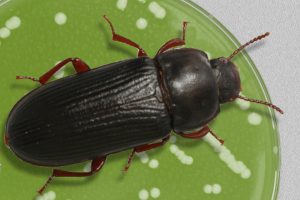Agathe Crosland PhD thesis
 Growth and reproductive, actuarial and immune senescence in an insect
Growth and reproductive, actuarial and immune senescence in an insect
Started in october 2020
Funding: doctoral grant
Supervisor: Yannick Moret ; cosupervisor : Thierry Rigaud
Defended the 7 march 2024
Abstract
Senescence, the decline of organism performance with age, is an quasi-universal and so very familiar phenomenon. However, the ‘why’ and ‘how’ of this phenomenon have only really begun to be elucidated recently. From an evolutionary perspective (the ‘why’), the decline in the strength of natural selection with age creates an opposition between early life and late life, generally to the detriment of the early period. As for the ‘how’, several mechanisms have been proposed. In particular, the disposable soma theory proposes that the decline of the organism is due to the accumulation of damage that has not been repaired or not completely repaired, because resources are allocated to other functions that are advantageous earlier in life, such as reproduction or growth.
While the link between reproduction and senescence has been extensively studied over the last century, the link between growth and senescence remains to be consolidated.
This thesis focuses on this relationship by testing the effect of growth rate on senescence with respect to three aspects (reproduction, survival and immunity) in the mealworm beetle, Tenebrio molitor (Coleoptera, Tenebrionidae). By employing two complementary approaches, one based on the modification of growth rate by the larval environment and the second based on inbred lines, this study shows that, under our experimental conditions, a stronger investment in growth, accelerates reproductive senescence and influences the type of immune defense favored by insects, but does not generate costs in terms of longevity.
Keywords
senescence, lifespan, immunity, growth speed, trade off, Tenebrio molitor
Thesis advisory panel
Jean-François Lemaître, UMR CNRS 5558 LBBE, UCB Lyon 1
Gabriele Sorci, UMR CNRS/uB/EPHE 6282 Biogéosciences, université de Bourgogne
Jury
Sophie Beltran-Bech, université de Poitiers – reviewer
François Criscuolo, université de Strasbourg – reviewer
Jean-François Lemaître, université Claude Bernard Lyon 1 – examiner
Bruno Faivre, université de Bourgogne – examiner
Yannick Moret, université de Bourgogne – supervisor
Thierry Rigaud, université de Bourgogne – cosupervisor
- extrait:
- lien_externe:
- titre:
- Croissance et senescence immunitaire, reproductive et actuarielle chez un insecte
- date_de_debut_these:
- octobre 2020
- nom:
- Crosland Agathe
- date_de_debut_these_numerique:
- 202010
- kc_data:
- a:8:{i:0;s:0:"";s:4:"mode";s:0:"";s:3:"css";s:0:"";s:9:"max_width";s:0:"";s:7:"classes";s:0:"";s:9:"thumbnail";s:0:"";s:9:"collapsed";s:0:"";s:9:"optimized";s:0:"";}
- kc_raw_content:
 Growth and reproductive, actuarial and immune senescence in an insect
Growth and reproductive, actuarial and immune senescence in an insectStarted in october 2020
Funding: doctoral grant
Supervisor: Yannick Moret ; cosupervisor : Thierry Rigaud
Defended the 7 march 2024
Abstract
Senescence, the decline of organism performance with age, is an quasi-universal and so very familiar phenomenon. However, the 'why' and 'how' of this phenomenon have only really begun to be elucidated recently. From an evolutionary perspective (the 'why'), the decline in the strength of natural selection with age creates an opposition between early life and late life, generally to the detriment of the early period. As for the 'how', several mechanisms have been proposed. In particular, the disposable soma theory proposes that the decline of the organism is due to the accumulation of damage that has not been repaired or not completely repaired, because resources are allocated to other functions that are advantageous earlier in life, such as reproduction or growth.
While the link between reproduction and senescence has been extensively studied over the last century, the link between growth and senescence remains to be consolidated.
This thesis focuses on this relationship by testing the effect of growth rate on senescence with respect to three aspects (reproduction, survival and immunity) in the mealworm beetle, Tenebrio molitor (Coleoptera, Tenebrionidae). By employing two complementary approaches, one based on the modification of growth rate by the larval environment and the second based on inbred lines, this study shows that, under our experimental conditions, a stronger investment in growth, accelerates reproductive senescence and influences the type of immune defense favored by insects, but does not generate costs in terms of longevity.
Keywords
senescence, lifespan, immunity, growth speed, trade off, Tenebrio molitor
Thesis advisory panel
Jean-François Lemaître, UMR CNRS 5558 LBBE, UCB Lyon 1
Gabriele Sorci, UMR CNRS/uB/EPHE 6282 Biogéosciences, université de BourgogneJury
Sophie Beltran-Bech, université de Poitiers - reviewer
François Criscuolo, université de Strasbourg - reviewer
Jean-François Lemaître, université Claude Bernard Lyon 1 - examiner
Bruno Faivre, université de Bourgogne - examiner
Yannick Moret, université de Bourgogne - supervisor
Thierry Rigaud, université de Bourgogne - cosupervisor
